Whoever first coined “patience is a virtue” must have been a sailor. It seems as though we are often practicing patience as we wait, and wait, and wait some more. We wait for the right weather window. We wait for the tides to rise. We wait for the bridges to open. We wait for big ships to cross. We wait for that powerboat bearing down behind us to pass. We wait for the fog to lift. We wait…
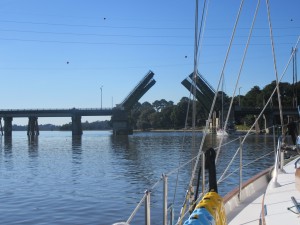
All of this waiting means that there are hours to while away (for the grammar folks, it is while and not wile), often at anchor or tied up at a marina. The Captain and I practice different methods of waiting. I prefer to stay busy doing something unrelated to our pending departure, so I write, sketch, catch up on FB, or clean. Otherwise, I think I’d go mad and we wouldn’t want mutiny to be the next blog post.
Dudley, on the other hand, checks and rechecks the weather, and the tides, and the charts. He checks and rechecks the engine fluids. He tweaks this and that. He listens to the VHF and sometimes watches the AIS if deeper vessels are transiting the skinny water that we are about to meet. In other words, he’s the ultimate captain. Yes, I could do all those things too (well, most of them) but if you think two cooks in the kitchen are dicey, you wouldn’t want to watch two captains on a small vessel. It would be an interesting reality show however.
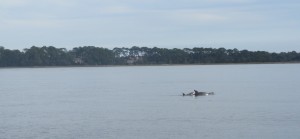
So here’s a peek into Days 43-45, where we practiced patience as we twisted and turned through the low marshlands of Georgia. In the evenings we anchored out in secluded marshes because 1) we wanted to enjoy peace and quiet, 2) it’s free, 3) there aren’t many marinas in these parts. But the days found us waiting for this or that.
Before weighing anchor on Day 43, we discovered a steady dripping leak of transmission fluid, which barely soaked the engine “diaper.” We added 6 ounces of transmission fluid and set off to meet our first trouble spot of the day. This one was called “Hell Gate” so that offers a clue as to why we waited for a rising tide. We actually made bets on how low the water would get beneath our keel. Whoever won (closest to actual reading) would NOT have to cook dinner that evening. Dudley guessed 1.8 feet and I guessed 2.5. The lowest reading was 5+ feet, so needless to say the Captain fixed dinner, and once again the First Mate marveled at how managing the tides gets good results.
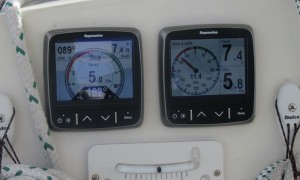
However, the engine diaper was quite a bit more soaked with leaking transmission fluid by the time we anchored in the Crescent River that night. We were anxious to get to our marina reservation on Jekyll Island on the afternoon of Day 44 so we could give this concern the proper attention. But fog on the morning of Day 44 delayed our departure. And the irritating thing about fog is that it’s hard to anticipate when it will lift. It appeared to lift at one point, and we started the engine. Then it set in again, so we turned the engines off. The waiting was excruciating. We were highly aware that each minute we waited meant that we would not be transitting the skinny waters of Jekyll Creek on a high tide.
Finally, we thought we’d give it a go. As we pulled up the anchor, two other boats down the creek did the same and we all exited at roughly the same time. As we did, the first boat disappeared into thickening fog. But we kept on, keeping the second boat in our sights. We were all motoring slowly, due to visibility. And still, the minutes ticked on as the tides were changing our strategy for skinnier waters ahead.
Finally, the fog lifted and we all sped up. There were twists and turns to be cautious about, and we were hesitant to pass the other boats ahead. So we waited. And that waiting, plus the fog waiting, put us further behind schedule. And rule number one is: Never sail to a schedule.
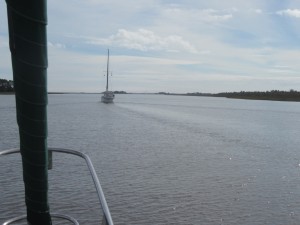
We did eventually pass the other boats, and throttled up the speed a bit more. But as time passed, it became apparent that we were cutting it too close to transit Jekyll Creek on a high tide. So we decided to anchor one more night so that we would avoid the risk of running aground on a falling tide (meaning if we ran aground, the waters would not be rising to save us). Plus we would be able to add transmission fluid when the engine was cold in the morning. Once safely anchored in Hawkins Creek, we called the marina to bump our reservation by one day, called their recommended mechanic to schedule a visit, postponed cocktails with friends at the marina, and exercised patience by enjoying yet another beautiful sunset.
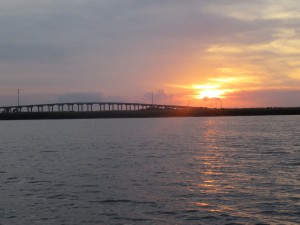
On Day 45, we entered Jekyll Creek on a rising tide, with at least 4’ of water above mean low. The skinniest water we saw was 2.5 under our keel. Yep, that means that a few hours before we would have been stuck in the mud. So we were glad we had waited, and not pushed it the previous day.
However, the creek was still tricky. We followed the ActiveCaptain reports, and made sure to line up with the ranges.
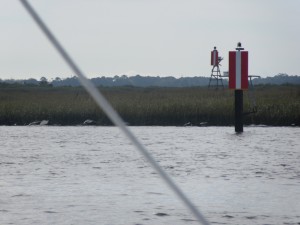
Yes, there are ranges, even for small boats like ours. Big cargo ships aren’t the only ones who get to have all the fun! For landlubbers: ranges are lights or markers that are placed so that sailors can align the shorter marker in front of the taller marker when entering a narrow channel, to prevent running aground. Jekyll Creek is notorious for grounding when not “in the channel” so having the markers helped us know we were in the best place (which isn’t always the middle of the channel).
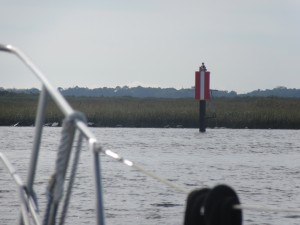
Before noon on Day 45, we were warmly welcomed at the Jekyll Harbour Marina. Their welcome sign was a nice touch, and their local mechanic met with Dudley to troubleshoot the transmission and order the part.
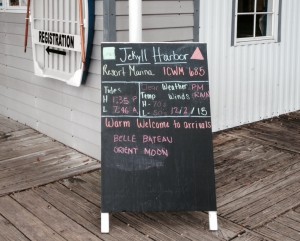
While repairs were being planned, I hopped on a courtesy bike for a quick tour of some island highlights, and returned in time to fix hors d’ouevres for cocktail hour with Paul and Linda, who live on their boat at this marina. Paul was Dudley’s instructor for his 50-ton Captain’s license five years ago, and it was good to catch up.
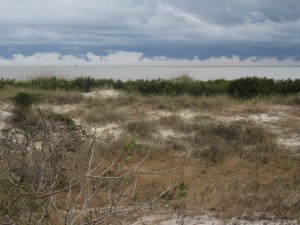
So all of that waiting and practicing patience paid off. We were safe in the lifting fog, we didn’t run aground, our engine was not damaged, we still had cocktails with friends, and we enjoyed another sunset at an anchorage we would have passed by. Life on a boat continues to be an exercise in patience, but it does have its rewards.
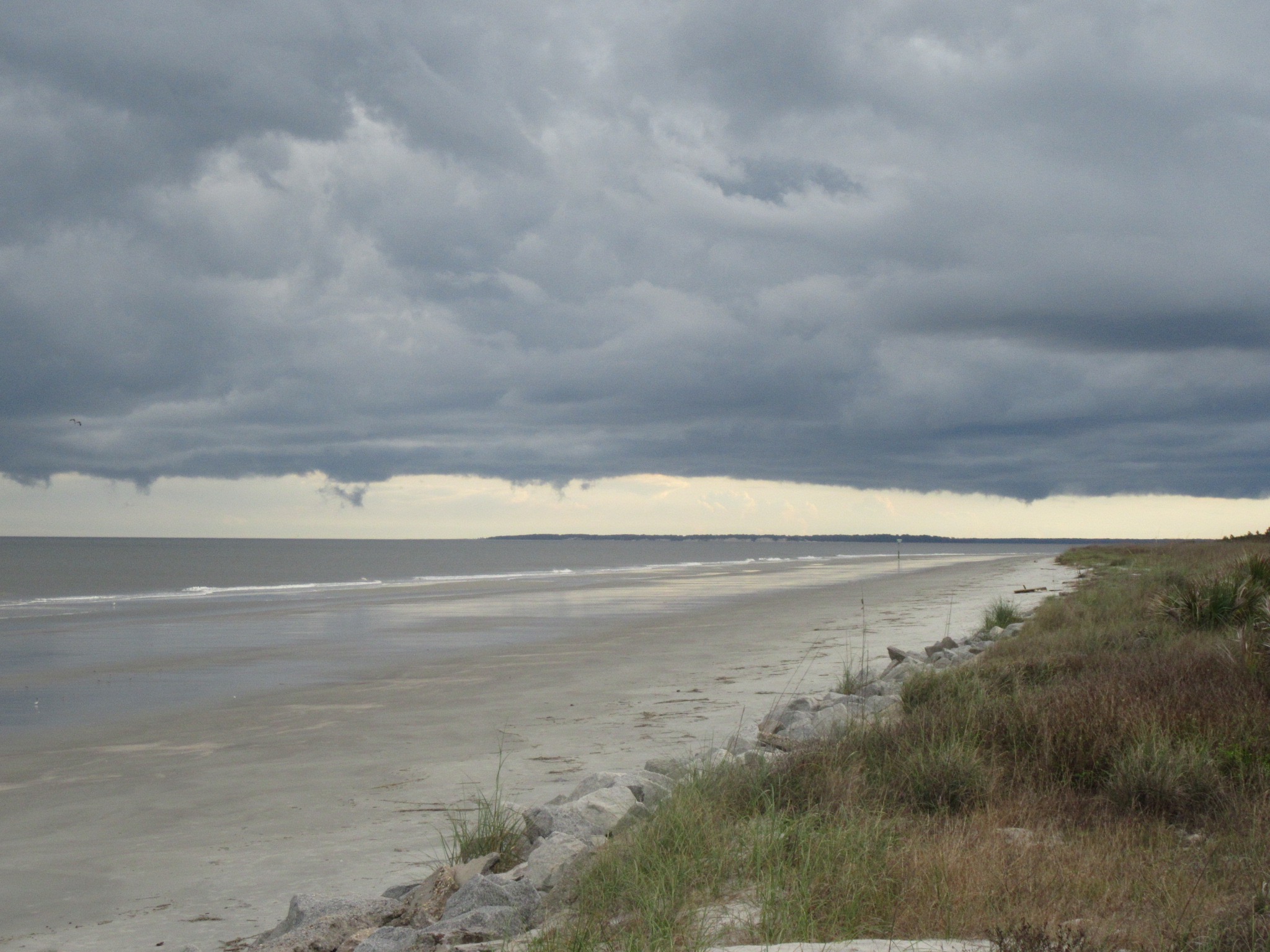
I am loving your journey! (On dry land)
Hugs + safe sailing mates!